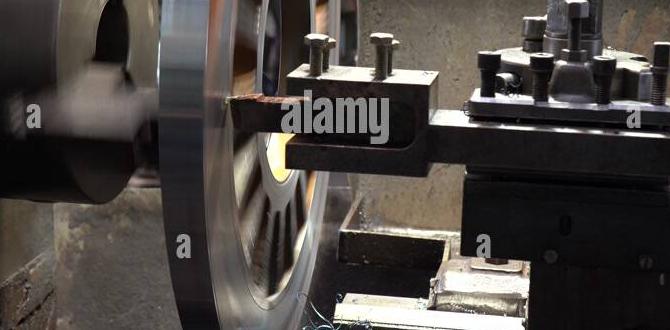Cut Inconel 718 with a carbide end mill by using the right tool geometry, slow speeds, steady feed rates, and ample coolant. Selecting a specialized, long-reach carbide end mill designed for exotic alloys ensures optimal performance and extends tool life, making this tough material manageable for beginners.
Tackling Inconel 718 can feel like trying to cut through steel with a butter knife. This superalloy is notoriously tough, sticky, and prone to work hardening, making it a nightmare for standard machining. Many beginners shy away from it, worried about breaking tools and ruining their workpieces. But what if we told you it’s entirely possible to mill Inconel 718 smoothly and efficiently, even with a carbide end mill? We’ll guide you through the process, showing you how to choose the right tools and set up your machine for success so you can confidently cut this challenging material.
Understanding Inconel 718: What Makes It So Tough?
Before we get into the cutting, let’s quickly touch on why Inconel 718 is such a beast. It’s a nickel-chromium superalloy, meaning it’s engineered for extreme environments where high temperatures, immense pressures, and corrosive conditions are the norm. Its strength comes from its ability to form a hardened layer on its surface when it heats up. This makes it incredibly resistant to wear, but also incredibly difficult to machine without the right approach.
Key characteristics that make machining Inconel 718 challenging include:
- High Strength: It retains significant strength even at elevated temperatures.
- Work Hardening: The material becomes harder and more difficult to cut the more it’s deformed.
- Low Thermal Conductivity: Heat generated during cutting tends to stay concentrated at the cutting edge, leading to rapid tool wear.
- Galling/Stickiness: The material tends to stick to the cutting tool, causing built-up edge and poor surface finish.
Why Carbide End Mills are Your Best Bet for Inconel 718
When you’re facing a material like Inconel 718, you need a cutting tool that can stand up to the abuse. While high-speed steel (HSS) tools might work for softer metals, they quickly overheat and dull against superalloys. This is where carbide end mills shine. Carbide, made from tungsten carbide particles bonded with a metal binder, is significantly harder and more heat-resistant than HSS. For Inconel 718, a specialized carbide end mill is practically a necessity.
Specifically, you’ll want a carbide end mill designed for exotic alloys. These often feature:
- Specific Geometries: Optimized flute forms and cutting edge angles to shear the material effectively rather than drag it.
- Coatings: Advanced coatings like TiAlN (Titanium Aluminum Nitride) or AlTiN (Aluminum Titanium Nitride) add a tough outer layer that resists heat and abrasion.
- High Positive Rake Angles: These help to create a sharper cutting edge and reduce cutting forces.
- Specialized Flute Designs: Designed to evacuate chips efficiently, preventing re-cutting and thermal buildup.
Choosing the Right Carbide End Mill: Key Features for Inconel 718
Not all carbide end mills are created equal, especially for a material like Inconel 718. When you’re shopping, look for these crucial features:
1. Material and Grade
For Inconel 718, you absolutely need a high-performance carbide grade. Look for end mills made from micrograin or sub-micrograin carbide. These offer a superior balance of hardness and toughness. Grades with a higher percentage of cobalt in the binder can sometimes offer better toughness, which is important for preventing chipping on the cutting edge.
2. Number of Flutes
This is a key decision. For Inconel 718:
- 2-flute end mills: Generally preferred for high-temperature alloys like Inconel. They provide more chip clearance, which is crucial for preventing chip recutting and the associated heat buildup. The reduced engagement also helps manage cutting forces.
- 3-flute or 4-flute end mills: While offering a smoother finish and faster material removal in softer materials, they can generate more heat and require more rigid setups due to increased engagement. For Inconel 718, it’s usually best to stick with 2 or 3 flutes to manage heat and chip evacuation effectively.
3. Coatings
Coatings are your best friend when cutting tough materials. For Inconel 718, look for:
- TiAlN (Titanium Aluminum Nitride): Excellent for high-temperature applications. It forms a very hard, protective layer that withstands heat and abrasion well.
- AlCrN (Aluminum Chromium Nitride): Another excellent option that provides superior thermal and oxidation resistance, often outperforming TiAlN at very high cutting temperatures.
- ZrN (Zirconium Nitride): Offers good resistance to galling and tends to have a lubricious surface, which helps prevent material buildup.
A good coating acts like a sacrificial layer, protecting the carbide substrate from the extreme heat and wear generated during the cut. You can learn more about the science behind cutting tool coatings and their applications on resources like Sandvik Coromant’s page on cutting tool coatings.
4. Geometry and Edge Prep
The shape of the cutting edge is critical. For Inconel 718, you want end mills with:
- High Positive Rake Angles: This means the cutting face is angled forward, creating a sharper cutting edge that slices through the material. It reduces the force needed to cut.
- Corner Radii or Chamfers: A small radius or chamfer on the corner helps to strengthen the edge and reduce the tendency for chipping. For Inconel 718, a sharp edge is important, but too sharp can lead to immediate chipping. A slight refinement like a radius is often better.
- Chip Breakers: Some end mills feature small notches on the cutting edge. These help to break up chips into smaller, more manageable pieces, which aids in chip evacuation and reduces the risk of recutting.
5. Long Reach and Shank Diameter
When cutting Inconel 718, especially in cavities or deep features, a long-reach end mill is crucial. However, there’s a trade-off. Standard long-reach end mills can be whippy and prone to vibration. For Inconel 718, you might need to compromise slightly on reach to ensure rigidity.
If you need to reach deep:
- Consider a solid carbide extension: This is often better than a long-reach end mill itself if extreme reach is required.
- Use a smaller diameter end mill: A 1/8 inch (3mm) or 1/4 inch (6mm) shank diameter end mill, even if long-reach, will have less deflection than a larger one.
- Look for end mills with a reinforced core: Some specialized end mills have a thicker core behind the cutting flutes to increase rigidity.
Example Keyword Focus: 1/8 inch (3mm) 6mm Shank Long Reach for Inconel 718 Long Tool Life
When searching for tools, keep this specific type in mind. A 1/8 inch (3mm) or 6mm shank diameter means you can achieve finer details and potentially run faster spindle speeds if your machine allows. The “long reach” aspect is important for accessing recessed areas, but always balance it with rigidity needs for Inconel 718. “Long tool life” is the goal, achievable through the correct geometry, coating, speeds, and feeds.
Setting Up Your Machine for Inconel 718
Even with the perfect end mill, your machine setup is critical. Inconel 718 demands a rigid machine, a secure workpiece, and a reliable coolant strategy.
1. Machine Rigidity
This is non-negotiable. Any flex in your machine – be it a mill or a lathe with milling capabilities – will lead to chatter, tool breakage, and poor surface finish. Ensure your machine spindle bearings are tight, ways are properly lubricated and adjusted, and any Z-axis slop is eliminated. A robust machine tool is paramount.
2. Workholding
Your workpiece must be held absolutely securely. For Inconel 718, use:
- Robust Vises: Ensure your milling vise is of high quality with hardened jaws. Position the Inconel workpiece as close to the fixed jaw as possible to minimize overhang.
- Tooling Blocks or Fixtures: For consistent production or critical holding, custom fixtures are ideal.
- Tight Tolerances: Ensure your workpiece is seated firmly against stops or datums.
Any movement of the workpiece during the cut is a recipe for disaster.
3. Coolant and Lubrication
Managing heat is arguably the most important factor when machining Inconel 718. You need a flood of coolant directed precisely at the cutting edge.
- High-Pressure Coolant: Standard coolant flow might not be enough. High-pressure systems (300-1000 PSI) can penetrate the cutting zone, flush away chips, and significantly cool the tool and workpiece.
- Ideal Coolant Types: Synthetics or semi-synthetics are often preferred for their cooling capabilities and cleanliness. For very tough cuts, a heavy-duty soluble oil can also work, but ensure it’s compatible with your machine and materials.
- Lubricants: In some extreme cases, a specialized high-temperature cutting paste or oil can be applied directly to the cutting edge for added lubrication. However, with good coolant and proper speeds/feeds, this is often unnecessary and can sometimes lead to chip packing.
The goal is to keep the cutting edge as cool as possible, preventing heat buildup that leads to work hardening and rapid tool wear. Refer to resources from organizations like the National Institute of Standards and Technology (NIST) for research into advanced machining processes and coolant technologies.
Feeds and Speeds: The Golden Rule for Inconel 718
This is where things get dialed in. The “magic numbers” for Inconel 718 are generally much slower and more deliberate than for steel or aluminum. The key is to maintain a consistent chip load and avoid rubbing. Rubbing creates heat without cutting, which is precisely what you want to avoid.
Surface Speed (SfM)
For carbide end mills in Inconel 718, you’ll typically be in the range of 20-60 Surface Feet per Minute (SfM). This translates to relatively low spindle RPMs, especially for larger diameter end mills. Start at the lower end of this range and increase if your setup is extremely rigid and you’re not experiencing chatter.
Chip Load (in/flute or mm/flute)
This is the thickness of the chip being removed by each cutting edge per revolution. This is crucial for ensuring you’re actually cutting and not rubbing. For a 1/8 inch (3mm) end mill in Inconel 718, you might be looking at:
- 0.0005 – 0.0015 inches per flute (0.012 – 0.038 mm per flute)
Always refer to your end mill manufacturer’s recommendations, as these values can vary based on the specific tool’s geometry, coating, and grade.
Calculating Spindle Speed (RPM)
Once you have your target Surface Speed (SfM) and your end mill diameter, you can calculate the spindle RPM using this formula:
RPM = (SfM × 3.82) / Diameter (inches)
Or for metric:
RPM = (SfM × 1000) / (π × Diameter (mm))
Example: For a 1/4 inch (6.35mm) diameter end mill and a target of 30 SfM:
RPM = (30 × 3.82) / 0.25 = 458.4 RPM
Calculating Feed Rate (IPM or mm/min)
This is the speed at which the tool moves through the material. You calculate this using the desired chip load and the number of flutes:
Feed Rate (IPM) = RPM × Number of Flutes × Chip Load (inches/flute)
Example (continuing from above): Using a 2-flute end mill with a chip load of 0.001 inches/flute at 458.4 RPM:
Feed Rate = 458.4 × 2 × 0.001 = 0.917 IPM
These calculated values are starting points. You’ll need to listen to the cut, watch for vibration, and check chip formation to fine-tune them. Inconel 718 often benefits from a steady, consistent feed rate without any hesitation.
Machining Strategies for Inconel 718
How you approach the cut is as important as the parameters you use.
1. Climb Milling vs. Conventional Milling
Climb milling is almost always preferred for Inconel 718. In climb milling, the cutter rotates in the same direction as the feed movement. This results in a slicing action that starts with a thin chip and grows thicker, reducing the impact on the cutting edge and reducing the tendency for it to dig in. Conventional milling, where the cutter rotates against the feed direction, tends to push the material onto the edge, increasing heat and wear.
2. Stepover and Depth of Cut
To manage heat and cutting forces, shallow depths of cut and moderate stepovers are generally recommended.
- Depth of Cut (DOC): Start conservatively, perhaps 0.010 to 0.050 inches (0.25 to 1.27 mm) depending on the tool diameter and machine rigidity.
- Stepover (Width of Cut): For roughing, a stepover of 25-50% of the tool diameter is common. For finishing, you might use a 10-20% stepover for a good surface finish.
3. Slotting and Pocketing
When creating slots or pockets, it’s crucial to manage chip evacuation.
- Peck Drilling/Plunging: If you need to plunge the end mill into the material, use a slow plunge rate and a shallow pecking depth (e.g., 0.050 inches or 1.27 mm) to clear chips.
- Helical Interpolation: For creating holes or pockets larger than your end mill, using a helical interpolation motion is a good way to mill out material with efficient chip evacuation.
- Avoid Retuning: Try to plan toolpaths so the end mill doesn’t have to re-enter already cut material in a way that traps chips.
4. Finishing Passes
After roughing, a light finishing pass can improve surface quality. Use a significantly reduced depth of cut and a fine stepover, ensuring the machine is still rigid and the coolant is flowing effectively.
Table: Recommended Starting Parameters for Inconel 718 with Carbide End Mills
These are general guidelines. Always consult your tool manufacturer’s specific recommendations and start conservatively.
| Operation | End Mill Diameter | Surface Speed (SfM) | Chip Load (in/flute) | Number of Flutes | Depth of Cut (in) | Stepover (%) | Coolant/Lube |
|---|---|---|---|---|---|---|---|
| Roughing | 1/4″ (6.35mm) | 25-40 | 0.001 – 0.0015 | 2 | 0.030 – 0.070 | 40-50% | Flood – High Pressure |
| Finishing | 1/4″ (6.35mm) | 30-50 | 0.0005 – 0.001 | 2-4 | 0.00
|






